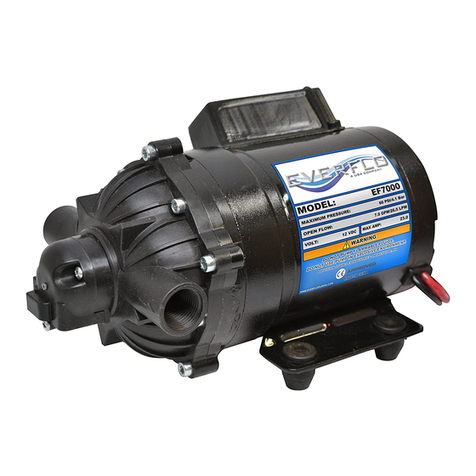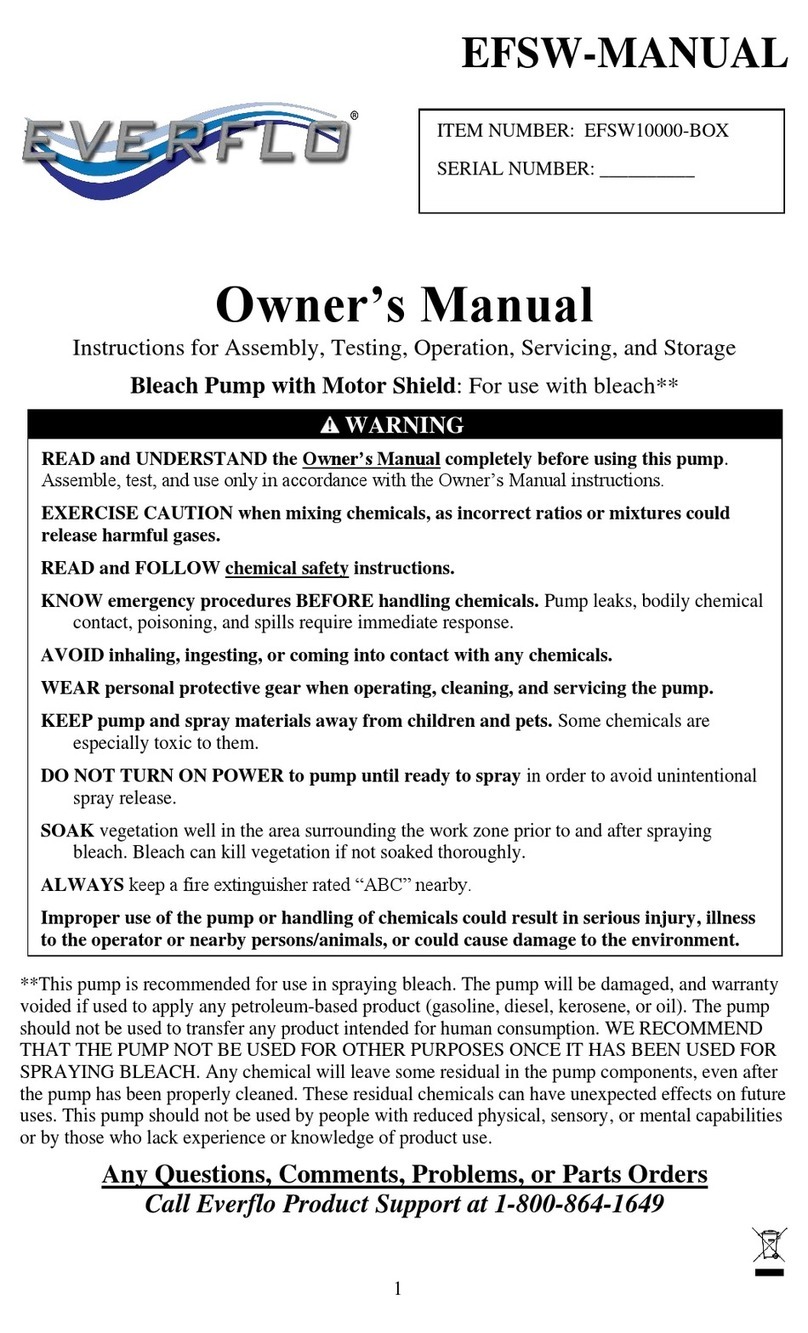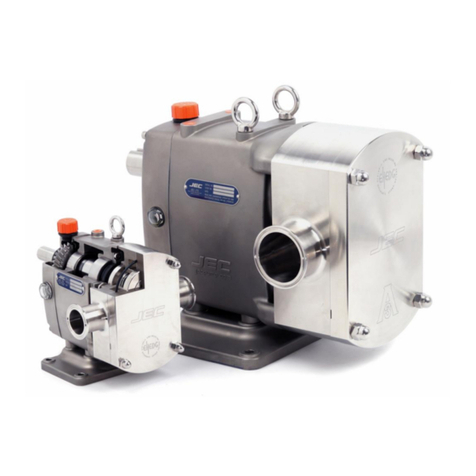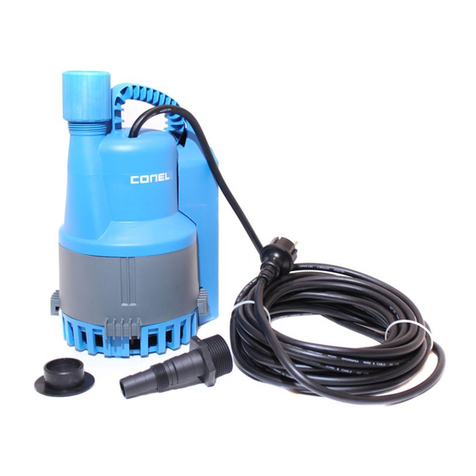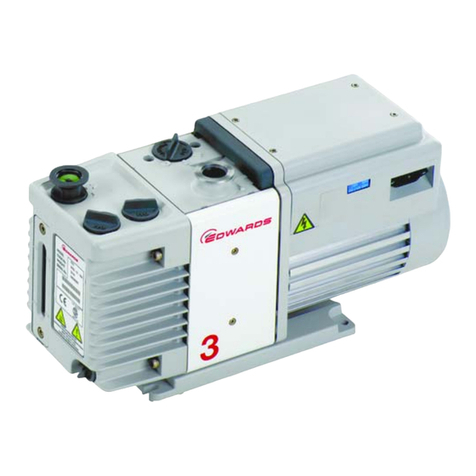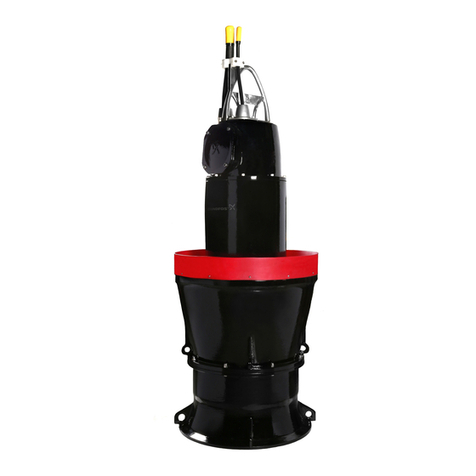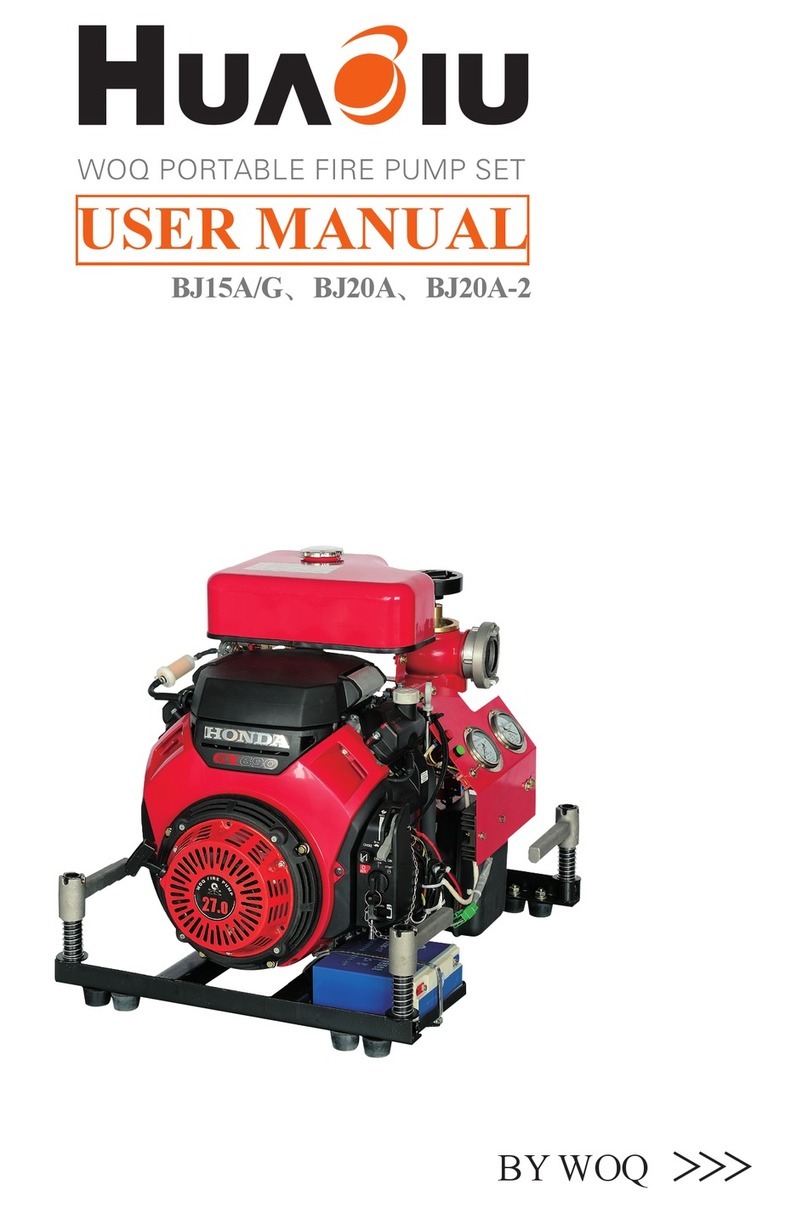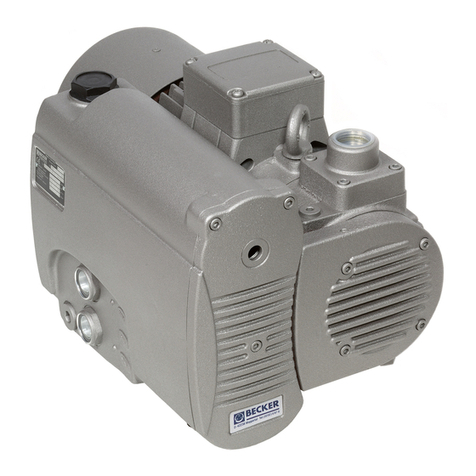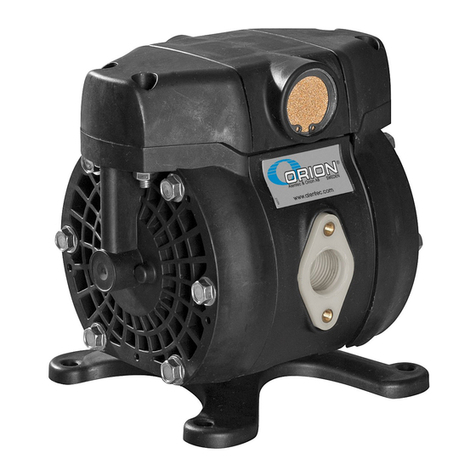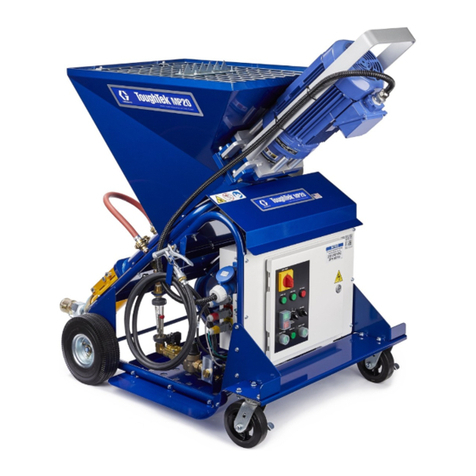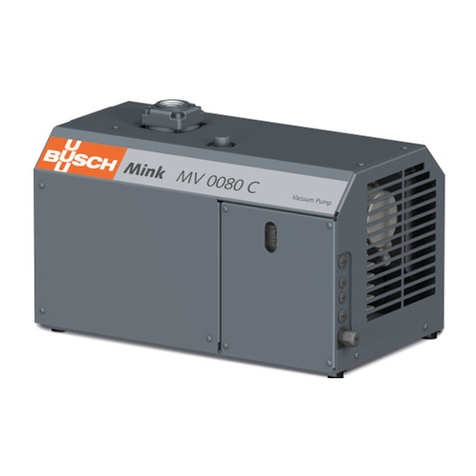Everflo EFHP-2000 User manual

EFHP-2000
Owner’s Manual
Instructions for Assembly, Testing, Operation, Servicing, and Storage
12V Plunger Pump: For use with non-potable liquids such as water-based
agricultural pesticides and other liquids**
WARNING
READ and UNDERSTAND the Owner’s Manual completely before using this pump.
Assemble, test, and use only in accordance with the Owner’s Manual instructions.
READ and FOLLOW chemical safety instructions. Pesticides are hazardous chemicals.
KNOW emergency procedures BEFORE handling chemicals. Pump leaks, bodily chemical
contact, poisoning, and spills require immediate response.
AVOID inhaling, ingesting, or coming into contact with any chemicals.
WEAR personal protective gear when operating, cleaning, and servicing the pump.
KEEP pump and spray materials away from children and pets. Pesticides are especially
toxic to them.
DO NOT TURN ON POWER to pump until ready to spray in order to avoid unintentional
spray release.
ALWAYS keep a fire extinguisher rated “ABC” nearby.
Improper use of the pump or handling of chemicals could result in serious injury or
illness to the operator or nearby persons/animals, or could cause damage to the
environment.
** This pump is recommended for use in spraying non-flammable liquids such as pesticides, water
for plants/trees or dust control, or water-based non-flammable sealants or stains for outdoor wood
surfaces. This pump should not be used to transfer any product intended for human consumption.
WE RECOMMEND THAT THE PUMP NOT BE USED FOR OTHER PURPOSES ONCE IT HAS
BEEN USED FOR SPRAYING PESTICIDES. Any chemical will leave some residual in the pump,
even after the pump has been properly cleaned. These residual chemicals can have unexpected
effects on future uses. For example, spraying water or other liquids that are contaminated with
residual pesticide may result in unforeseen hazards to plant or animal life. This pump should not be
used by people with reduced physical, sensory or mental capabilities or lack of experience and
knowledge.
Any Questions, Comments, Problems, or Parts Orders
Call Everflo Product Support 1-800-864-1649
ITEM NUMBER: EFHP-2000
SERIAL NUMBER: __________

Hazard Signal Word Definitions
2

Table of Contents
3
Intended Use ........................................................................................................................................ 4
Summary of Important Safety Information...................................................................................... 5
During Assembly
During Operation
General Chemical Safety
Chemical Applicator Safety
Chemical Accident Procedures
Warning Label Location...................................................................................................................... 7
Unpacking ............................................................................................................................................. 8
Assembly................................................................................................................................................ 9
Installation
Step One: Mounting...................................................................................................................... 13
Step Two: Plumbing...................................................................................................................... 13
Step Three: Connect pump to vehicle battery............................................................................... 14
Step Four: Check and test completed assembly ........................................................................... 15
Operation
Important Safety Information - Operation.............................................................................. 16
General Chemical Safety
Chemical Applicator Safety
Chemical Accident Procedures
Preparing the Pump for Each Use............................................................................................. 20
Using the Pump
Step One: Assess wind conditions and clear work area........................................................ 21
Step Two: Operate the pump................................................................................................. 21
Step Three: Clean pump and decontaminate after use .......................................................... 23
Storage................................................................................................................................................. 25
Preparing for storage
Removing from storage
Troubleshooting.................................................................................................................................. 26
Specifications....................................................................................................................................... 28
Accessories........................................................................................................................................... 29
Parts Breakdown – Exploded View.................................................................................................. 30
Limited Warranty .............................................................................................................................. 31

Intended Use
4
The pump is intended for use in spraying agricultural pesticides and other non-flammable
liquids.
SPRAYING PESTICIDES:
Pesticides are hazardous chemicals that must be handled with caution as directed
throughout this manual and on the pesticide label. Pesticides are regulated by the United
States Environmental Protection Agency (EPA) and defined as:
Any substance or mixture of substances intended for preventing, destroying, repelling, or
mitigating any pest. Though often misunderstood to refer only to insecticides, the term
pesticide is a comprehensive term that applies to insecticides, herbicides, fungicides, and
various other substances used to control pests.
The pump is intended for use in spraying pesticides in liquid form only. The pump is
NOT intended for use in spraying pesticides in dry or aerosolized form, or for use with
fumigants.
SPRAYING OTHER LIQUIDS:
In addition to spraying pesticides, this pump may be used to spray other non-flammable
liquids. Example uses include: watering plants/trees or spraying water for dust control,
or applying water-based, non-flammable sealant or stain to outdoor wood surfaces.
However, WE RECOMMEND THAT THE PUMP NOT BE USED FOR OTHER
PURPOSES ONCE IT HAS ALREADY BEEN USED FOR SPRAYING
PESTICIDES. Any chemical will leave some residual in the pump, even after the pump
has been properly cleaned. These residual chemicals can have unexpected effects on
future uses. For example, spraying water or other liquids that are contaminated with
residual pesticide may result in unforeseen hazards to plant or animal life.
Contact Everflo Product Support at 1-800-864-1649 for any questions about
the appropriate use of the pump and/or optional accessories.

Summary of Important Information
5
WARNING
Read and understand this owner’s manual completely before using the pump. Read each
chemical label’s instructions before handling the chemical.
Improper use of the pump or handling of chemicals could result in serious injury or illness
for the operator or nearby persons/animals, or cause damage to the environment.
LISTED BELOW is a summary of safety information of particular importance. See individual
sections of this owner’s manual for more details.
------------------------------------ DURING ASSEMBLY-------------------------------
EXERCISE CAUTION when attaching remote switch to battery terminals. Follow the steps
listed in the Assembly section of this manual in exact sequence when connecting the pump to battery
terminals. Caution must be exercised to avoid contact with battery acid and to prevent sparking.
CHECK and TEST completed assembly as directed in this manual. Serious injury could result from
chemical leaks if pump is improperly assembled.
DO NOT MODIFY pump design.
------------------------------------DURING OPERATION------------------------------
General Chemical Safety
READ and FOLLOW each chemical label’s instructions and warnings.
AVOID inhaling, ingesting, or coming into contact with any chemicals.
KNOW applicable licensing and regulatory requirements for the chemical you plan to use.
KNOW emergency procedures before handling chemicals. Carefully review “Chemical Accident
Procedures” listed below and later in this manual. Also see First Aid instructions on the chemical
label.
WEAR protective clothing, eye protection, and chemical resistant gloves when operating the
pump. Wear additional protective gear, such as facemask or apron, as recommended on the chemical
label.
EXERCISE EXTRA CAUTION around children and pets. Pesticides are especially toxic to them.
Keep pump and spray materials away from them at all times.
DO NOT MIX OR POUR chemicals in an enclosed, unventilated area
DO NOT USE flammable or corrosive chemicals in the pump.
FLUSH the pump before switching chemicals in order to prevent dangerous chemical interactions.
STORE pesticides in a correctly labeled container and in a secure location.
MONITOR the health of operators frequently exposed to pesticides, as recommended by the
chemical label or local/federal regulations.
Chemical Application Safety
Before Spraying
INSPECT and PREPARE pump before each use as directed in this manual.
DO NOT TURN ON POWER to pump until ready to spray in order to avoid unintentional spray
release.
DO NOT SPRAY when wind speed exceeds 4 MPH in order to minimize spray drift.
CLEAR work area of people/ pets and POST warning notices to restrict access for the period
recommended on chemical label.
KEEP pump and spray materials away from children/pets. Pesticides can be especially toxic to
children and animals.
DO NOT ALLOW anyone younger than 16 to operate the pump since pesticides are especially
toxic to children.
During Spraying
DO NOT OVER-APPLY pesticide. Apply at rate recommended by chemical manufacturer. Excess
pesticide can be dangerous to humans/animals, damage desirable plants, and contaminate soil and
water sources.

Summary of Important Information
6
DO NOT EAT, DRINK, SMOKE, RUB YOUR EYES, or TOUCH YOUR BARE SKIN while
handling chemicals and spraying.
NEVER POINT A SPRAY GUN at people or animals.
EXERCISE EXTRA CAUTION when spraying near areas accessible to children and pets.
CLEAN up spills immediately per instructions on the chemical label.
TURN OFF power to pump, and RELIEVE system pressure before leaving pump unattended.
SEE Troubleshooting section of this manual before attempting any repairs. Wear personal
protective equipment and follow safety instructions.
After Spraying
CLEAN pump immediately after use according to the directions provided in this manual.
DECONTAMINATE yourself after you are done spraying and have cleaned the pump. Wash all
exposed areas of the body with soap and water, and remove and launder clothing.
DISPOSE OF or STORE remaining chemicals in secure storage with correctly marked
container.
Chemical accident procedures
Immediate response is necessary in the event of pump leaks, bodily chemical contact, poisoning, or
spills. See instructions below:
Pump leak If the pump develops a leak, immediately stop spraying. Turn off power to the
pump and follow directions below, as applicable.
Bodily
chemical
contact
Personal contamination can occur when chemicals splash, spill, or spray
directly onto a person.
1. Immediately follow First Aid instructions on chemical label.
General procedures can include:
a) Eyes – immediately flush with water.
b) Skin – wash all contaminated skin surfaces with soap and water.
c) Clothing – remove contaminated clothing. Dispose of heavily
contaminated clothing per chemical label instructions.
2. Seek medical advice if instructed on the label or the victim experiences
symptoms of harmful effects. Bring the chemical label for reference.
Poisoning by
ingestion or
inhalation
In case of poisoning from ingestion or inhalation:
If the victim has collapsed or is not breathing, call 911. Otherwise:
1. If you are the victim, immediately seek assistance from nearby personnel
because you may become incapacitated.
2. Immediately follow first aid instructions on chemical label.
3. Call a poison control center for further advice. In the U.S., call 1-800-222-
1222. Have the chemical label available for reference.
Chemical
spills Chemical spills must be quickly contained and properly cleaned up.
Refer to the chemical label for any specific clean-up instructions.
General procedures include:
1. Controlling the spill by stopping the source of the spill.
2. Containing the spill so that it does not spread and get into water sources.
3. Cleaning up the spill immediately.
4. Seeking additional advice from:
- Chemical manufacturer. See chemical label for contact information.
- State pesticide regulatory agency. In the U.S., call the National Pesticide
Info. Ctr. at 800-858-7378 for assistance in contacting your state’s agency.

Warning Label Location
7
Always make sure safety labels are in place and in good condition. If a safety label is missing or
not legible, order new labels or unsafe operation could result.
To order replacement safety labels, call Everflo Product Support at 1-800-864-1649.
Part# Description
796106 EFHP2000 Pump Label
793288 Pump Warning Label
DO NOT PUMP FLAMMABLE FLUIDS. DO NOT USE PUMP IN AN EXPLOSIVE
ENVIRONMENT. READ AND UNDERSTAND THE OWNER’S MANUAL COMPLETELY
BEFORE USING. RELIEVE SYSTEM PRESSURE BEFORE PERFORMING MAINTENANCE.
WARNING

Unpacking
8
Closely inspect all contents in the shipping carton.
If you have missing or damaged components, please contact Everflo Product Support at
1-800-864-1649
Plunger Pump
P/N EFHP2000
Regulator Assembly
Regulator: EF-792943
Quick Connect x 1/2” Hose barb (1)
P/N EF-QC-A12
*(1) Pre-installed on Regulator
Quick Connect Plug (2)
P/N EF-789160
*(1) Pre-installed on Pump
Quick Connect x 3/8” Elbow (1)
P/N EF-QC-EL38
*(1) Pre-installed on Regulator
Quick Connect x 1/2” Elbow (2)
P/N EF-QC-EL12
¼” MNPT Plug (2)
P/N F14
*(1) Pre-installed on Regulator

Assembly
9
Step 1 – Inlet Fitting Installation
Install (1) QC x 1/2” HB elbow fitting into the pump inlet port on the
bottom left side of the pump manifold.
Install (1) QC x 1/2” HB elbow fitting into the pump inlet port on the
bottom right side of the manifold.
oUse a flat blade screwdriver to remove QC clip from the pump before
installing fitting. Snap QC clip back into pump after fitting is inserted.
Note: The pump is configured for installing (2) QC x 1/2” HB elbow fittings
into the pump inlet ports on the bottom of the manifold. If preferred to
use only one pump inlet port, there is an extra QC plug in the manual
bag that can be installed to plug the desired port.
Tools Needed
Flat blade
screwdriver
Pump inle
t
QC x 1/2” Elbow
Inlet fitting
QC Clip
QC x 1/2” Elbow
Inlet fitting
Pump inle
t
QC Clip
QC Clip
Pump port
Insert screw-
driver here to
remove QC clip

Assembly
10
Step 2 – Plug or Optional Gauge Installation
Install either the 1/4” MNPT Plug or Optional Gauge into the 1/4” FNPT
port on the regulator.
oUse a wrench to thread the plug or gauge into the regulator port.
Tools Needed
Wrench
Regulator assembly
1/4” MNPT Plug Optional Gauge:
P/N 2141GXB300

Assembly
11
Step 3 – Regulator Installation
Install the regulator into outlet port at the top right side of the
pump manifold.
oUse flat blade screwdriver to remove QC clip from the
pump before installing fitting. Snap QC clip back into
pump after fitting is inserted.
Note: The pump is configured for installing the regulator in the
right side of the manifold. If the left side is preferred, the QC
plug must first be moved from the left side outlet port to the
right side outlet port.
Tools Needed
Flat blade
screwdriver
QC Clip
Regulator assembly
Outlet port
QC Plug

Assembly
12
Step 4 – Connect Inlet, Outlet, and Bypass Hoses
Use a hose clamp (not provided) and connect a flexible hose (not
provided) to the regulator’s bypass port. The hose should return
to the pump’s water supply. See the Operation section of the
manual for detailed information about the regulator’s bypass
function.
Use hose clamps (not provided) and connect flexible hoses (not
provided) to the pump’s inlet and outlet ports. See the
Installation section of the manual for more detailed plumbing
requirements.
Tools Needed
Flat blade
screwdriver
1/2” Inlet hose
(from water supply)
1/2” Inlet hose
(from water supply)
3/8” Outlet hose
1/2” Bypass hose
(return to water supply)
* Hoses and Hose Clamps are not provided
Regulator
bypass port
Hose clamp

Installation
13
Step One: Mounting
This Everflo pump performs best with a flooded inlet. (The pump’s inlet should be located
below the supply water level.) If the pump must be placed above the water supply, suction
lift is not to exceed two feet (0.6m).
CAUTION
NEVER operate the pump dry. Catastrophic failure will occur. All plunger pumps require
liquid to lubricate the seals and keep them from overheating.
The pump should be located in an area that is dry and provides adequate ventilation.
The pump must be mounted in a horizontal position.
Secure the rubber feet with #10 (M5) fasteners. DO NOT compress the feet, doing so will
reduce their ability to isolate vibration/noise. (Note: fasteners are not included.)
Step Two: Plumbing
See table below for port size and recommended hose sizes.
oUse Everflo quick connect fittings to connect flexible high pressure tubing.
oMaximum pump operating pressure is 200psi (13.8bar). Outlet hose working
pressure must be rated appropriately.
oA pressure regulator is included with the pump and must be used.
Pump
Model Minimum inlet
hose size
Minimum
outlet hose
size
Outlet hose
working
pressure
(minimum)
Bypass hose
diameter
EFHP-2000 1/2" (13mm)
Inside diameter 3/8" (9.5mm)
Inside diameter 200psi (13.8bar) 1/2” (13mm)
NOTE: Everflo does not recommend the use of metal fittings or rigid pipe to plumb the inlet/outlet
ports. Standard plastic threaded fittings are available by calling Everflo Product Support at 1-
800-864-1649.
Tubing should be compatible with the spraying fluid. At least 18"[450mm] length is
suggested to minimize stress on the fitting/ports and reduce noise. Allow for the shortest
possible tubing route and avoid sharp bends that may kink over time.
Installation of a 50-mesh strainer is required to prevent foreign debris from entering the
system. Failures due to foreign debris are not covered under the warranty.
NOTE: Restrictions on the inlet may cause a loss in performance and shorten pump life. Inlet pressure
must not exceed 30 psi [2.1 bar]
If a check valve is installed in the plumbing, it must have a cracking pressure of no more
than 1 psi [.07 bar].
CAUTION
DO NOT locate the motor near low temperature plastics or combustible material. The surface
temperature of the motor may exceed 250°F [121°C].
CAUTION
Sealers and Teflon tape may act as lubricant causing cracked housings or stripped threads due to
over tightening. Care should be used when applying sealers; it may enter the pump inhibiting
valve action, causing no prime or no shut-off. Failures due to foreign debris are not covered
under the warranty.

Installation (continued)
14
Step Three: Connect pump to battery or 12V supply
WARNING
Batteries are hazardous because they contain caustic acid, can emit explosive gases, and can
cause electric shock.
Caution must be exercised when making connections to a battery to avoid shock and contact with
the acid, and to prevent any sparking that could lead to an explosion.
ALWAYS follow the safety instructions and steps listed below in exact sequence when
connecting the pump to the battery terminals.
1. Preparatory
safety
Preparatory safety steps:
ALWAYS use eye protection
NEVER smoke or work near sparks or other sources of ignition.
NEVER touch both battery terminals at the same time or with any
non-insulated tools.
If battery acid contacts skin or clothing, flush immediately with water
and neutralize with baking soda.
2. Electrical
requirements The pump should be on a dedicated (individual) circuit, controlled
with a double pole switch (UL/CSA certified) rated at or above the
fuse ampere indicated by the pump motor label. Depending on
distance of the power source from the pump and ampere load on the
circuit, wire may need to be heavier than indicated by the chart.
The pump is protected with a fuse. Use an approved wire of the size
specified or heavier.
Voltage Model Fuse
(amp) Wire Leads Wire Size
(Stranded MTW)
12 VDC EFHP-2000 20.0 RED (positive +)
BLACK (negative -) #12 AWG (4.0mm2)
(or heavier)
Note: Use #10 AWG (5.0mm2) for wire lengths over 12 feet (3.6m). Do not
exceed 25 feet (7.6m) of total wire length.
A remote switch is included for temporarily shutting off the pump’s operation.
Call Everflo Product Support at 1-800-864-1649 to order replacement remote
switch Everflo Item #EF-794292.
3. Connect pump
to battery
Connect the pump to a 12V DC battery using the following procedure:
a) Disconnect the vehicle battery ground wire.
b) Connect the pump clamp with the red wire to the positive (+) terminal
of the battery.
c) Connect the pump clamp with the black wire to the negative (-)
terminal of the battery.
d) Reconnect the vehicle battery ground wire.
Note: Skip steps (a) and (d) if battery is not in a vehicle.
WARNING: Always connect in this sequence to avoid possible shock.

Installation (continued)
15
4. Disconnect
after use AFTE
R
EACH USE, disconnect power to the pump using the following
procedure:
a) Disconnect the vehicle battery ground wire.
b) Disconnect the pump clamp with black wire from the negative (-)
terminal of the battery.
c) Disconnect the pump clamp with red wire from the positive (+)
terminal of the battery.
d) Reconnect the vehicle battery ground wire.
Note: Skip steps (a) and (d) if battery is not in a vehicle.
WARNING: Always disconnect in this sequence to avoid possible shock.
NOTE: It is important to disconnect power to the pump when not in use for
safety reasons. ALWAYS verify that the power has been disconnected
before adding chemicals or servicing.
Step Four: Check and test completed assembly.
WARNING
Check and test completed assembly
Serious injury could result from chemical leaks if pump is improperly assembled or the design
of the pump is modified.
Follow the steps below to ensure the pump is properly assembled. Never modify the pump
design.
1. Check
assembly Check assembly to assure the pump is properly assembled and in safe
working condition:
2. Before
starting the
pump
a) Test the system for leaks with water
b) Ensure water supply is adequate. Do not run dry.
c) Check inlet strainer for debris.
d) Verify hoses are in good condition and all connections are tight.

Operation – Important Safety Information
16
Now that you have completed and tested your assembly, there is some important safety and health
information you need to know with regard to handling and spraying chemicals.
WARNING
Carefully read and make sure you understand the following safety information before
using the pump.
General Chemical Safety:
WARNING
Pesticides are hazardous chemicals.
Heed the warnings below and follow all instructions carefully.
Improper handling of chemicals can result in serious injury or illness, or cause damage to the
environment.
Chemical label. ALWAYS READ and FOLLOW all chemical label instructions.
Licensing/regulation. Refer to any applicable licensing restrictions or state/federal regulations
with regard to the application of the particular chemical you plan to use.
Emergency procedures. Before handling chemicals, carefully review the “Chemical Accident
Procedures” listed later in this section, as well as the “Statement of Practical Treatment” on the
chemical label.
Inhalation/contact. ALWAYS take precautions to avoid inhaling or coming into contact with
the chemical.
Personal protective equipment. ALWAYS wear protective clothing, eye protection, and
chemical-resistant gloves when operating and cleaning the pump. Wear additional protective
gear (such as facemask or apron) as recommended on the chemical label.
Children/pets. Pesticides can be especially toxic to children and animals. ALWAYS exercise
extra caution around children. Keep pump and all spray materials away from children and
animals.
Ventilation. ALWAYS ensure there is adequate ventilation when mixing, pouring, or spraying.
Flammables. NEVER use any flammable chemicals in the pump.
Corrosives. DO NOT use corrosive chemicals in the pump. They can weaken the pump and its
parts, resulting in leaks. Check with the chemical manufacturer to ensure chemical is
compatible with all components of the pump.
Chemical interaction. ALWAYS flush the pump before switching chemicals. Different
chemicals may interact dangerously with each other.
Chemical storage. ALWAYS store pesticides in a properly labeled container and in a secure
location per the manufacturer’s recommendations.
Health monitoring. Monitor the health of operators who are frequently exposed to pesticides,
as recommended by the chemical label or local/federal regulations.

Operation – Important Safety Information (continued)
17
Chemical Application Safety:
WARNING
Caution must be used when spraying chemicals to avoid unsafe exposure to humans and the
environment.
Heed the warnings below and follow all instructions carefully.
Before Spraying
Pump prep. ALWAYS inspect and prepare the pump before use according to the directions
provided in this manual.
Keep pump off. Do not turn on power to the pump until ready to spray in order to avoid
unintentional spray release.
Wind speed. NEVER spray when wind speed exceeds 4 MPH in order to minimize spray drift.
Clear area/post. ALWAYS keep the work area clear of people and pets. POST warning
notices to restrict access by the public for the period recommended on chemical label.
Operator age. You must be 16 years of age or older to operate this pump. Pesticides are
especially toxic to children.
During Spraying
Over-application. DO NOT over-apply pesticide. Apply at a rate recommended by chemical
manufacturer. Excess pesticide can be dangerous to humans, damage desirable plants, and
contaminate soil and water sources.
Children/pets. ALWAYS exercise extra caution when spraying near areas accessible to
children and pets.
Eating/smoking. DO NOT eat, drink, smoke, rub your eyes, or touch any part of your bare skin
while handling chemicals and spraying.
Heat/flames. DO NOT spray near open flames or sources of heat.
Spills. ALWAYS clean up spills immediately per instructions on the chemical label.
Unattended. ALWAYS turn off power to pump, and relieve system pressure before leaving
pump unattended.
Troubleshooting. ALWAYS refer to the safety instructions in the Troubleshooting Section
before attempting any repairs.
After Spraying
Clean pump. ALWAYS clean the pump immediately after use according to the directions
provided in this manual.
Decontaminate. ALWAYS decontaminate yourself immediately after you are finished
spraying and handling chemicals. Wash all exposed areas of the body with soap and water and
remove and launder clothing.
Chemical disposal/storage. ALWAYS dispose of or store remaining chemicals properly as
recommended on the chemical label.

Operation – Important Safety Information (continued)
18
Chemical accident procedures:
WARNING
Before you use the pump, review the following information with regard to handling
accidents.
Chemical spills, pump leaks, personal contamination, and poisoning are accident situations
which you may encounter.
All require an immediate response – See instructions below.
Pump leak In the event that the pump develops a leak while spraying chemicals, you
must immediately stop spraying.
Turn off power to the pump and follow the directions below, as
applicable.
Bodily chemical
contact Personal contamination can occur when chemicals splash, spill, or spray
directly onto a person.
1. Follow the emergency first aid instructions on the chemical label listed in
the “First Aid” or “Statements of Practical Treatment” section.
General procedures include:
a) Eyes – immediately flush with water or follow other directions as
specified on the chemical label.
b) Skin – immediately wash all contaminated skin surfaces with soap
and water, or follow directions as specified on the chemical label.
c) Clothing – remove contaminated clothing immediately. Dispose of
heavily contaminated clothing per the instructions on the chemical
label for safe chemical/container disposal.
2. Seek medical advice if instructed on the label, or if the victim experiences
symptoms of harmful effects such as burning, swelling, nausea, chest
pain, difficulty breathing, dizziness or confusion. When seeking medical
advice, be sure to bring the chemical product label.
Poisoning by
ingestion or
inhalation
In case of poisoning from ingestion or inhalation:
IF THE VICTIM HAS COLLAPSED OR IS NOT BREATHING, CALL
911. Otherwise:
1. If you are the victim, immediately seek assistance from nearby personnel
because you may become incapacitated.
2. Follow the emergency first aid instructions on the chemical label in the
“First Aid” or “Statement of Practical Treatment” section.
3. Call a poison control center for further advice. In the U.S., call 1-800-
222-1222 to be automatically linked to the nearest certified poison
control center. Have the chemical label available for reference.
Chemical spills Chemical spills must be quickly contained and properly cleaned up.
Refer to the chemical label for any specific clean-up instructions with regard
to the chemical spilled.

Operation – Important Safety Information (continued)
19
General procedures include:
1. Control the spill by stopping the source of the spill. If the source of the
spill is a container leak, place the leaking container in a larger, watertight
container. Keep unprotected people away from the spill site.
2. Contain the spill so that it does not spread and get into water sources.
Use a shovel or other tool to make a dike around the spill with soil, sod,
or absorbent material.
3. Clean up the spill immediately -- Absorbent materials like ground
corncobs or pet litter should be spread on the spill area to soak up the
pesticide. The contaminated material should then shoveled into a leak-
proof container. Do not flush the spill area with water until you receive
advice as directed below.
4. Seek additional advice from the chemical manufacturer and your state’s
pesticide regulatory agency regarding decontamination of the spill site:
- Chemical manufacturer. The chemical label provides contact
information for the chemical manufacturer.
- State pesticide regulatory agency. In the U.S., call the National
Pesticide Information Center at 1-800-858-7378 for assistance in
determining how to contact your state’s pesticide regulatory
agency.

Operation – Preparing the Pump for Each Use
20
If the pump has been used previously, it must be prepared BEFORE EACH SUBSEQUENT USE.
WARNING
Read instructions below carefully for inspecting and preparing the pump.
Damaged or clogged equipment could result in leaks or uncontrolled spray.
Leaks could result in injury to the operator or bystanders from chemical exposure, or cause
damage to the environment.
Important safety rules:
Power off. Make sure all power is OFF before cleaning, inspecting, or servicing the pump.
Guards / shields. Make sure all guards and shields are replaced after servicing the pump.
Replacement parts. If a part needs replacement, only use parts that meet the manufacturer’s
specifications. Replacement parts that do not meet specifications may result in a safety
hazard or poor operation of the sprayer.
1. Ensure clean
system Ensure the pump has been thoroughly flushed and drained of all
residual chemicals from prior uses.
2. Inspect &
repair Inspect and test the sprayer thoroughly:
a) Inspect hoses/ lines for exposed mesh and holes. Replace all worn
or damaged hoses/ lines.
b) Inspect fittings for cracks and leaks. Replace all damaged fittings
with original Everflo parts.
c) Partially fill system with plain water and spray to test for leaks.
Repair as needed.
IMPORTANT: After any repair work has been done, ALWAYS test for
leaks with water one final time before using.
Be certain the pump materials will be compatible with the chemical being pumped. Everflo pumps are
intended for intermittent or continuous duty when the proper operating criteria are met. If unsure of the
chemical compatibility with the Everflo pump components or the motor’s intended design, please call
Everflo Product Support at 1-800-864-1649 for assistance.
Table of contents
Other Everflo Water Pump manuals
Popular Water Pump manuals by other brands

Crane
Crane PROSSER HYMERGIBLE 7-06000 Series Installation and operation manual
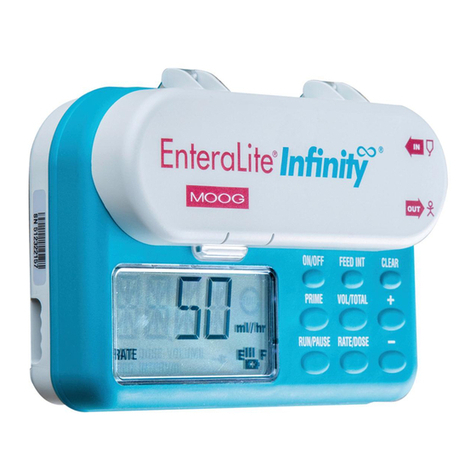
Moog
Moog Enteralite Infinity Field guide

Reefe
Reefe RainPro RM5000 Installation Guide & Owners Information

Lincoln
Lincoln QUICKLUB 203 owner's manual

AL-KO
AL-KO HW 4000 FCS manual
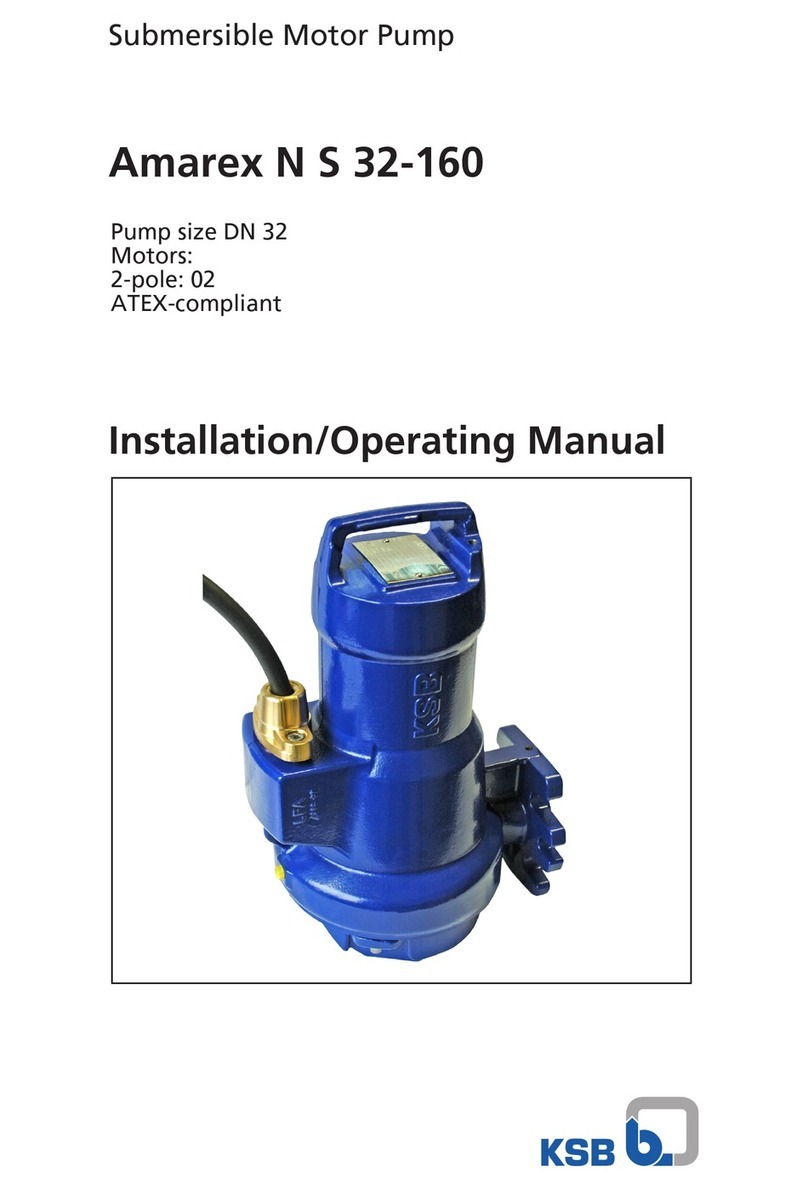
KSB
KSB Amarex N S 32-160 Installation & operating manual
